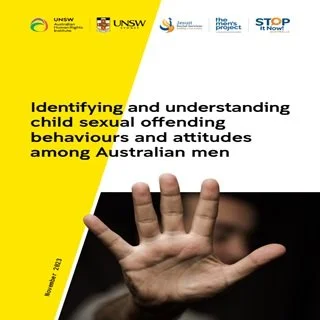Identifying and Understanding Child Sexual Offending Behaviours and Attitudes Among Australian Men.
By M Salter, D Woodlock, T Whitten, M Tyler, G Naldrett, J Breckenridge, J Nolan, N Peleg
This project aimed to inform efforts to better detect and prevent child sexual abuse through a rigorous analysis of the prevalence and attitudinal, behavioural and demographic correlates of sexual feelings and/or offending against children amongst Australian men. The research measured the prevalence of offending and risk behaviours and attitudes amongst of a weighted sample of 1,945 Australian men over 18 years of age. Key findings of the project Around one in six (15.1%) Australian men reports sexual feelings towards children. Approximately one third of this group reports sexually offending against children. Around one in ten (9.4%) Australian men has sexually offended against children. Approximately half of this group (4.9%) reports sexual feelings towards children. In total, almost one in five (19.6%) Australian men in the study have sexual feelings for children and/or have sexually offended against children. The 4.9% of men with sexual feelings who have sexually offended against children differed from men with no sexual feelings or offending against children on a number of measures: Relationships Ź They were more likely to be married and reported higher levels of social support. Employment and wealth Ź They were almost three times more likely to be working with children. Ź They were more likely to earn a higher income. Health and wellbeing Ź They were more likely to report mild, moderate or severe anxiety and depression. Ź They were over four times more likely to report weekly binge drinking. Childhood abuse and neglect Ź They reported approximately twice the rate of adverse childhood experiences. Ź They were over six times more likely to report being sexually abused as children. Attitudes to child sexual abuse Ź They were more than 25 times more likely to hold attitudes conducive to online child sex offending. Online behaviour Ź They were more likely to use the internet more frequently and intensively. Ź They were much more active on social media. Ź They were significantly more likely to use encrypted apps and privacy services. Ź They were twice as likely to own cryptocurrency and over five times more likely to use cryptocurrency for online purchasing. Pornography consumption Ź They were over eleven times more likely to watch violent pornography and over twenty six times more likely to watch bestiality pornography. Ź They were over sixteen times more likely to purchase sexual content online. 29.6% of those with sexual feelings towards children want help; this is 4.5% of Australian men. These men were more likely to have sexually offended against children online and offline than men with sexual feelings who did not want help.
Sydney: Australian Human Rights Institute, 2023. 56p.


